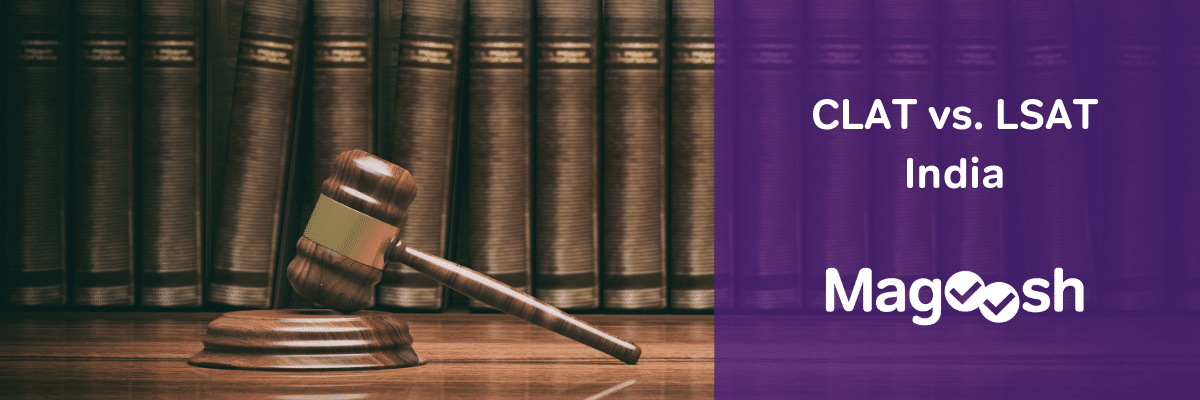
If you’re wondering whether to take the CLAT or LSAT, you’re in the right place. We’re going to look at the CLAT vs LSAT India, how they differ and compare, and whether you should give the CLAT or LSAT.
Let’s start by looking at what the CLAT is exactly.
What is the CLAT?
The CLAT, or the Common Law Admission Test, is a qualifying exam given in India. It is specifically for admission into an undergraduate or postgraduate law program at one of the CLAT Consortium of National Law Universities (NLUs). The CLAT Consortium designs and administers the CLAT annually, and sets out the CLAT eligibility requirements.
Next, let’s see what differentiates the CLAT from LSAT India.
CLAT vs LSAT India
Like the LSAT India, the CLAT is an entrance exam for high school students interested in studying law in India. (Unlike in the US where students start law school after college, Indian students start studying law after high school as a five-year program.) While the LSAT India is designed by the Law School Admissions Council (LSAC), the CLAT is designed by the CLAT Consortium.
In general, the LSAT India is more widely accepted. As of 2019, there are 53 law schools in India, referred to as the associated colleges that accept the LSAT India. On the other hand, only the 21 NLUs of India accept the CLAT.
In addition to these differences, the structure of the two exams also varies. The CLAT consists of 200 multiple choice questions, which must be answered in just two hours. On the LSAT India, you have two hours and twenty minutes to answer around 100 questions. Also, you are penalized for any wrong answers on the CLAT, unlike the LSAT India or the LSAT in the US.
If you’re trying to decide between the CLAT or LSAT India, you may want to consider how you feel about maths. The CLAT contains questions testing elementary mathematics, while the LSAT India and the LSAT do not in any way test your math skills. Definitely something to consider if numbers aren’t your thing!
In addition, the CLAT tests general knowledge and current affairs. The LSAT India does not require any outside knowledge—it tests only logical reasoning and analytical skills based on the information presented on the test.
Now that you have a sense of the differences between the exams, let’s take a look at how to decide which test is right for you.
Should I give the CLAT or LSAT?
If you’re wondering whether you should give the CLAT or LSAT, you need to consider where you are planning to attend law school. If you are in the United States or are planning to attend law school in the US, you’ll need to take the LSAT. On the other hand, if you are a student in India planning to attend an Indian law school, you will need to choose between the CLAT or LSAT India.
When deciding between the CLAT or LSAT India, the biggest factor will be where you want to study law. As mentioned above, the CLAT is only accepted by the 21 schools that make up the CLAT Consortium. If you are not interested in attending any of those schools, you should focus on the LSAT India.
One final factor is to consider the subject matter tested on the exam. You want to do your absolute best on whatever exam you end up taking. So, take some time to consider your strengths and weaknesses, and review the content and skills tested on the CLAT vs LSAT India. If you excel in mathematics and legal aptitude, the CLAT is the exam for you. If not, you’re in luck—neither are tested on the LSAT India.
CLAT Registration Date
All students interested in registering for the CLAT will need to submit an online application with the CLAT Consortium. Every year there’s a particular enrollment period, so check the CLAT Consortium instructions to find out the exact dates for your year.
For a sample timeline, let’s review the CLAT 2019 dates. The online enrollment was open from January 13 through April 15, and the exam was administered on May 26, 2019. So, you’ll have some time to register, but be sure to mark your calendars for January to start checking on enrollment periods.
Recap
The CLAT is one of two law school entrance exams administered in India. Unlike the LSAT India, the CLAT is quite different than the LSAT offered in the US. The CLAT tests general knowledge, legal aptitude, and elementary mathematics. Finally, only 21 law schools, aka the CLAT Consortium, accept the CLAT. No matter which exam you choose, we wish you the best of luck!





